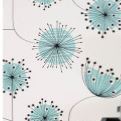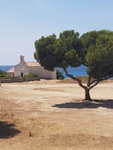 LombalgiaNiveau 10
LombalgiaNiveau 10
Bonjour,
Un-e collègue d'anglais pourrait-il-elle m'aider à améliorer ce texte destiné à présenter une petite exposition. Il y aura aussi la version française bien sûr, que je vous épargne à cause de tous les noms à abréger. D'ailleurs désolé pour toutes les initiales répétitives et propres à embrouiller. Malgré tout la version anglaise présente est-elle compréhensible en l'état ? Un tas de corrections ou améliorations est sans doute nécessaire. D'avance merci pour l'aide que vous pourrez m'apporter.
Two sisters artists from E.
Daughters of E., MD et MM both developed an amateur artistic practice.
Their parents were from two E. hamlets : Les L. for their father MM, P. for their mother AM. They married in 1920. He was a charcoal burner and a day agricultural labourer on occasion. She worked as a village seamtress. They had vineyard and gardens and worked on subsistence crops, with small farm breeding : chicken, rabbit, sheep and goats herd. They also had a donkey.
Their three children, first the son M1., then M2 and M3 were born in a house that no longer exists. It was attached at right angles with a barn used by the family and that has now been replaced by the exhibition hall where you are standing. The house where the M children started their life could be very old, maybe a part of the presbitary. All visitors were struck by the first floor wooden beams, ornamented with polychrome motifs. In the years 1930-1940, the family moved in the house overlooking the village square and the main street. An old postcard from 1950/1960, viewed from the air, shows the buildings diplay.
The three children attended school in E. then in C., then for personal and professional purposes travelled close or far from E. M2 and M3 both achieved a career in public service. Until the end of the eighties the village house remained the parents one, where their children and grand children were coming for visits and stays.
M2
M-A, nicknamed M2, was born in 1926. As a child she enjoyed drawing and imagining fantasy gardens. Later on she married JD and established in O. where she worked as a school teacher. After retiring M1 took oil painting class. She worked on still ilfe, landscapes of her garden and of the L. and S. area, on the motif. In 1987 M2 and her husband left O. to settle on the CA. Taking, collecting and using photographs of her favorite spots she composed imaginary riviera landscapes, still using oil, then more and more acrylics. She also composed several representations of E. and of the countryside of her charentaise childhood. Her paintings took part in collective exhibitions in O then in N. MD, born M, died in N. in 2022. She was almost 96.
M3
A venir
Un-e collègue d'anglais pourrait-il-elle m'aider à améliorer ce texte destiné à présenter une petite exposition. Il y aura aussi la version française bien sûr, que je vous épargne à cause de tous les noms à abréger. D'ailleurs désolé pour toutes les initiales répétitives et propres à embrouiller. Malgré tout la version anglaise présente est-elle compréhensible en l'état ? Un tas de corrections ou améliorations est sans doute nécessaire. D'avance merci pour l'aide que vous pourrez m'apporter.
Two sisters artists from E.
Daughters of E., MD et MM both developed an amateur artistic practice.
Their parents were from two E. hamlets : Les L. for their father MM, P. for their mother AM. They married in 1920. He was a charcoal burner and a day agricultural labourer on occasion. She worked as a village seamtress. They had vineyard and gardens and worked on subsistence crops, with small farm breeding : chicken, rabbit, sheep and goats herd. They also had a donkey.
Their three children, first the son M1., then M2 and M3 were born in a house that no longer exists. It was attached at right angles with a barn used by the family and that has now been replaced by the exhibition hall where you are standing. The house where the M children started their life could be very old, maybe a part of the presbitary. All visitors were struck by the first floor wooden beams, ornamented with polychrome motifs. In the years 1930-1940, the family moved in the house overlooking the village square and the main street. An old postcard from 1950/1960, viewed from the air, shows the buildings diplay.
The three children attended school in E. then in C., then for personal and professional purposes travelled close or far from E. M2 and M3 both achieved a career in public service. Until the end of the eighties the village house remained the parents one, where their children and grand children were coming for visits and stays.
M2
M-A, nicknamed M2, was born in 1926. As a child she enjoyed drawing and imagining fantasy gardens. Later on she married JD and established in O. where she worked as a school teacher. After retiring M1 took oil painting class. She worked on still ilfe, landscapes of her garden and of the L. and S. area, on the motif. In 1987 M2 and her husband left O. to settle on the CA. Taking, collecting and using photographs of her favorite spots she composed imaginary riviera landscapes, still using oil, then more and more acrylics. She also composed several representations of E. and of the countryside of her charentaise childhood. Her paintings took part in collective exhibitions in O then in N. MD, born M, died in N. in 2022. She was almost 96.
M3
A venir
 Lord StevenExpert
Lord StevenExpert
Quelques remarques rapides car le temps me manque pour une relecture exhaustive: flocks of goats (herds plutôt pour les vaches) she took classes (pluriel) moved TO a house. Pour le presbytère, presbytery est normalement pour les catholiques, parsonage pour les anglicans, donc à vous de voir.
_________________
If you play with a cat, you should mind his scratch

 HocamSage
HocamSage
Euh non, d'où cela sort-il ? Les deux sont possibles, et if anything l'option herd est peut-être un peu plus commune. Ce n'est en tout cas pas du tout la première chose à corriger ici... En revanche, la structure herds of goats est préférable, ou même plus simplement goats dans le contexte de la phrase ("chickens, rabbits, sheep and goats").Lord Steven a écrit:Quelques remarques rapides car le temps me manque pour une relecture exhaustive: flocks of goats (herds plutôt pour les vaches)
Il y a d'autres petites choses à revoir même si c'est globalement clair, je regarderai plus précisément demain.
 dandelionVénérable
dandelionVénérable
Merriam-Webster (https://www.merriam-webster.com/words-at-play/a-drudge-of-lexicographers-presents-collective-nouns) recommande d’utiliser ‘herd’ seulement pour les bovins. Voulais-tu parler de troupeaux de moutons et de chèvres ou uniquement de chèvres?
Tu as écris ‘diplay’ je suppose pour ‘display’. Si tu veux parler de la disposition des bâtiments, ce n’est pas le mot qui convient selon moi. J’ai envie d’utiliser layout mais c’est plutôt pour la disposition intérieure.
J’enlèverais ‘imagining’ dans l’expression ‘drawing and imagining’ puisque tu emploies déjà fantasy, qui cela dit n’est pas le terme approprié ici non plus (fantastical? fairy-tale?).
Sinon je pense que c’est compréhensible, même si les abréviations rendent le texte difficile à suivre en l’état.
Tu as écris ‘diplay’ je suppose pour ‘display’. Si tu veux parler de la disposition des bâtiments, ce n’est pas le mot qui convient selon moi. J’ai envie d’utiliser layout mais c’est plutôt pour la disposition intérieure.
J’enlèverais ‘imagining’ dans l’expression ‘drawing and imagining’ puisque tu emploies déjà fantasy, qui cela dit n’est pas le terme approprié ici non plus (fantastical? fairy-tale?).
Sinon je pense que c’est compréhensible, même si les abréviations rendent le texte difficile à suivre en l’état.
 nonoHabitué du forum
nonoHabitué du forum
Par curiosité, j'ai soumis le texte à Chatgpt et voilà ce que ça donne. Franchement, c'est pas mal du tout :
Two sisters, MD and MM, from E., were both amateur artists.
Their parents originated from two hamlets in E.: Les L. for their father MM and P. for their mother AM. They got married in 1920. MM worked as a charcoal burner and occasional agricultural laborer, while AM worked as a village seamstress. They owned vineyards and gardens and engaged in subsistence farming, including raising chickens, rabbits, sheep, and goats. They even had a donkey.
The couple had three children. Their son, M1, was followed by M2 and M3. The children were born in a house that no longer exists. This house was connected at a right angle to a barn used by the family, which has now been replaced by the exhibition hall you are currently in. The house where the M children began their lives may have been very old, possibly a part of the presbytery. Visitors were always impressed by the polychrome motifs adorning the wooden beams on the first floor. In the 1930s and 1940s, the family moved to a house overlooking the village square and the main street. An old aerial postcard from the 1950s or 1960s depicts the arrangement of the buildings.
The three children attended school in E., then in C. They later traveled near and far from E. for personal and professional reasons. Both M2 and M3 pursued careers in public service. Until the late 1980s, the village house remained the property of their parents, where their children and grandchildren would come to visit and stay.
M2, whose nickname was M-A, was born in 1926. As a child, she enjoyed drawing and creating imaginary gardens. Later on, she married JD and settled in O., where she worked as a school teacher. After retiring, M1 took oil painting classes and focused on still lifes and landscapes of her garden, as well as the L. and S. areas. In 1987, M2 and her husband left O. to live in CA. She used photographs of her favorite spots to compose imaginary Riviera landscapes, initially using oil and later transitioning to acrylics. She also painted several depictions of E. and the countryside of her Charentaise childhood. Her paintings were exhibited in group exhibitions in O. and later in N. MD, born M, passed away in N. in 2022 at the age of almost 96.
Two sisters, MD and MM, from E., were both amateur artists.
Their parents originated from two hamlets in E.: Les L. for their father MM and P. for their mother AM. They got married in 1920. MM worked as a charcoal burner and occasional agricultural laborer, while AM worked as a village seamstress. They owned vineyards and gardens and engaged in subsistence farming, including raising chickens, rabbits, sheep, and goats. They even had a donkey.
The couple had three children. Their son, M1, was followed by M2 and M3. The children were born in a house that no longer exists. This house was connected at a right angle to a barn used by the family, which has now been replaced by the exhibition hall you are currently in. The house where the M children began their lives may have been very old, possibly a part of the presbytery. Visitors were always impressed by the polychrome motifs adorning the wooden beams on the first floor. In the 1930s and 1940s, the family moved to a house overlooking the village square and the main street. An old aerial postcard from the 1950s or 1960s depicts the arrangement of the buildings.
The three children attended school in E., then in C. They later traveled near and far from E. for personal and professional reasons. Both M2 and M3 pursued careers in public service. Until the late 1980s, the village house remained the property of their parents, where their children and grandchildren would come to visit and stay.
M2, whose nickname was M-A, was born in 1926. As a child, she enjoyed drawing and creating imaginary gardens. Later on, she married JD and settled in O., where she worked as a school teacher. After retiring, M1 took oil painting classes and focused on still lifes and landscapes of her garden, as well as the L. and S. areas. In 1987, M2 and her husband left O. to live in CA. She used photographs of her favorite spots to compose imaginary Riviera landscapes, initially using oil and later transitioning to acrylics. She also painted several depictions of E. and the countryside of her Charentaise childhood. Her paintings were exhibited in group exhibitions in O. and later in N. MD, born M, passed away in N. in 2022 at the age of almost 96.
_________________
Prof en LP
 LombalgiaNiveau 10
LombalgiaNiveau 10
Wow incredible ! Chatgpt, vraiment ?
Je continue à prendre des avis, y compris sur la version artificielle, assez séduisante.
Merci pour votre aide à tous !
Je continue à prendre des avis, y compris sur la version artificielle, assez séduisante.
Merci pour votre aide à tous !
 nonoHabitué du forum
nonoHabitué du forum
Oui, sur Chatgpt et ça a pris 5 secondes.
Ceci dit, la tonalité est plutôt américaine mais je n'ai pas vu d'incohérences majeures. Peut-être que les collègues pourront proposer
des rectificatifs.
Je suis personnellement bluffée par cet outil même si une supervision du texte final est, à mon sens, toujours nécessaire.
Ceci dit, la tonalité est plutôt américaine mais je n'ai pas vu d'incohérences majeures. Peut-être que les collègues pourront proposer
des rectificatifs.
Je suis personnellement bluffée par cet outil même si une supervision du texte final est, à mon sens, toujours nécessaire.
_________________
Prof en LP
 HocamSage
HocamSage
Ce n'est pas ce que dit ton lien, Webster ne recommande pas herd uniquement pour les bovins mais explique de grandes tendances historiques et rappelle que les deux mots sont utilisés indifféremment aujourd'hui ("this jumble continued on in the modern era"). Le Shorter Oxford Dictionary indique p. 666 que herd s'utilise d'un groupe d'animaux se déplaçant ensemble, en particulier les hoofed mammals donc y compris les goats. Une simple recherche d'occurrences montre par ailleurs que "a herd of goats" revient légèrement plus souvent que "a flock of goats" aujourd'hui comme je le disais plus haut. En tout état de cause, vu le texte de départ, ce point est sans doute loin d'être la priorité, d'autant qu'on peut simplement nommer l'animal sans nom collectif, comme les autres animaux de la liste (c'est d'ailleurs ce que fait Chat GPT visiblement).dandelion a écrit:Merriam-Webster (https://www.merriam-webster.com/words-at-play/a-drudge-of-lexicographers-presents-collective-nouns) recommande d’utiliser ‘herd’ seulement pour les bovins. Voulais-tu parler de troupeaux de moutons et de chèvres ou uniquement de chèvres?
Cette version IA me paraît globalement satisfaisante par ailleurs. Effectivement, c'est l'orthographe américaine qui a été choisie ("laborer", "traveled"), il faut voir si c'est cohérent avec le reste (si reste il y a). Le style est améliorable parfois ("exhibited in group exhibitions" > "presented/displayed/shown in group exhibitions" plutôt par exemple) mais c'est clair et assez précis syntaxiquement et lexicalement.
Permission de ce forum:
Vous ne pouvez pas répondre aux sujets dans ce forum




